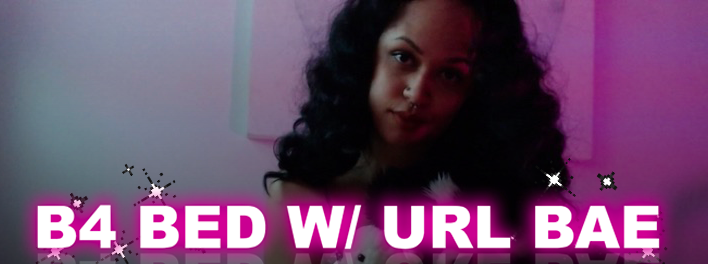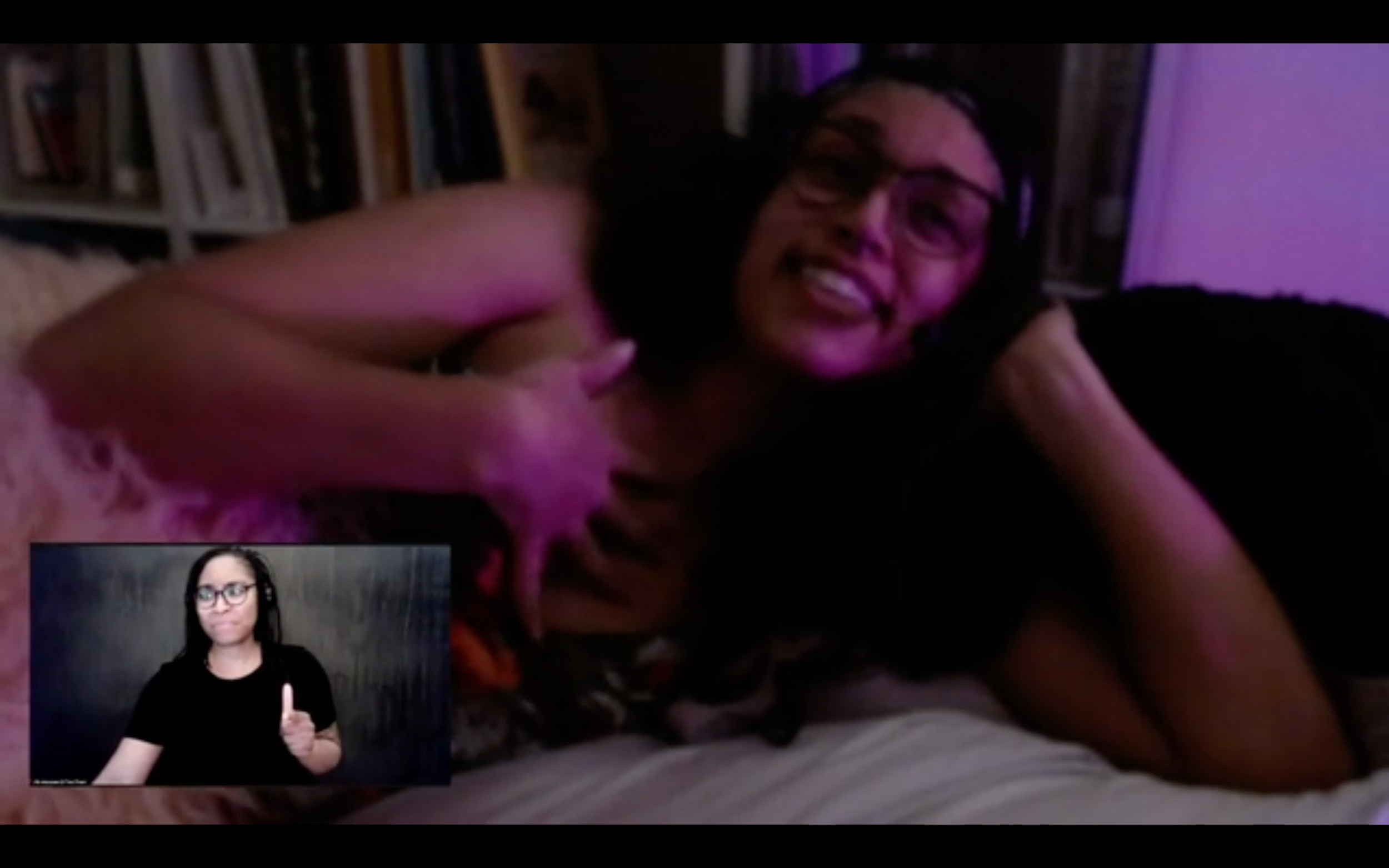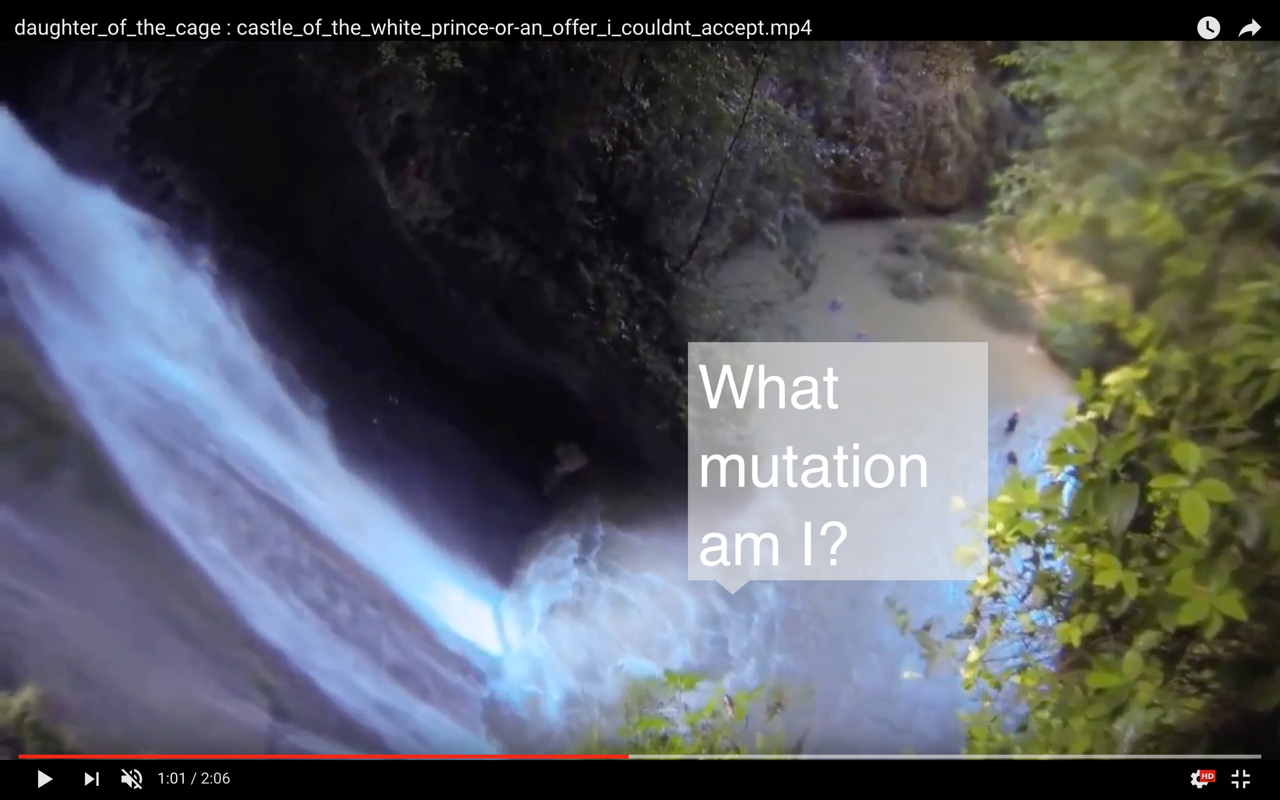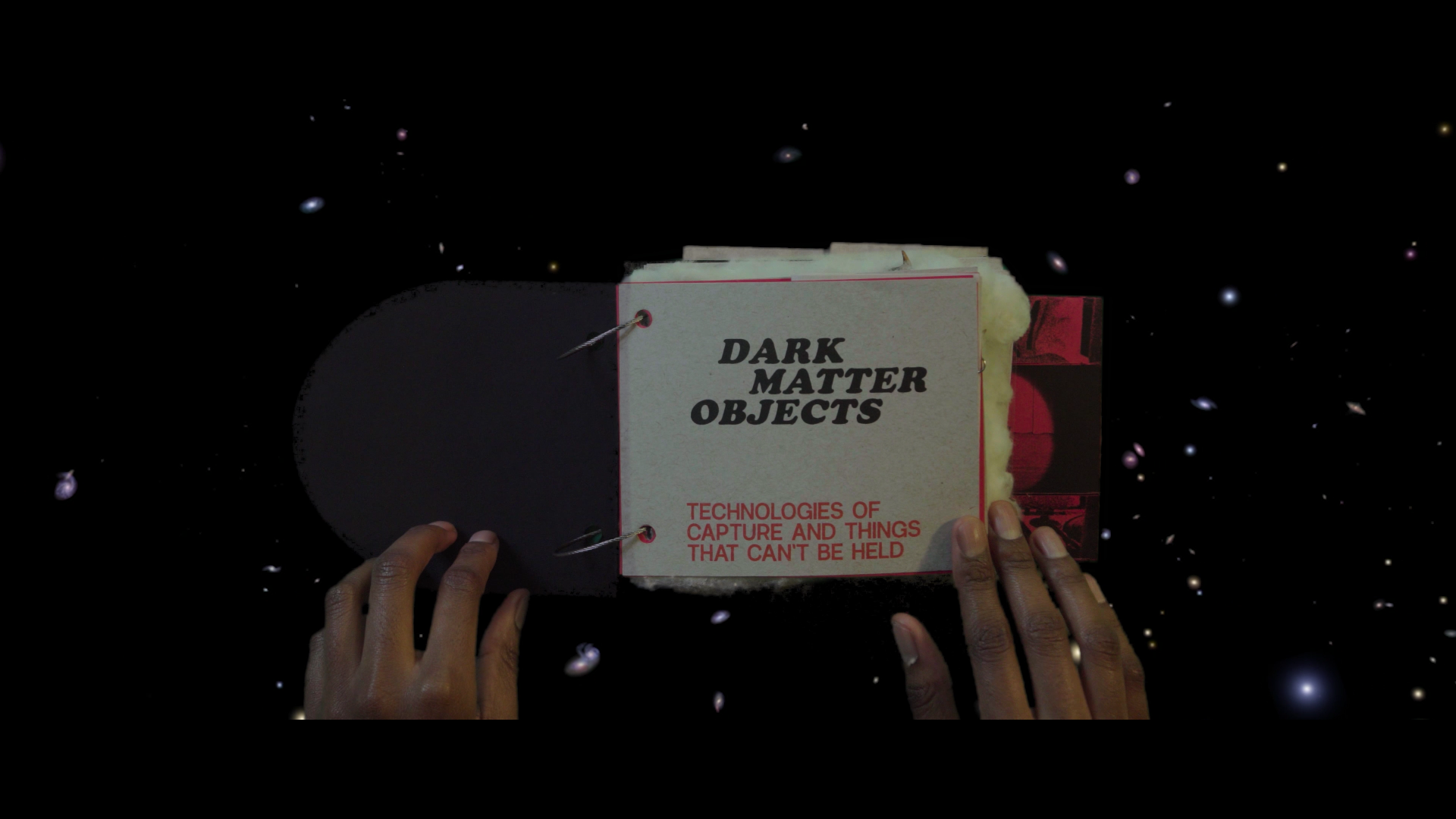
On View: April 22
This Video Viewing Room features SHAWNÉ MICHAELAIN HOLLOWAY's videos, define escalation (?) or what is a ride and how much are they selling it for (?) . mpeg (2016) and “castle_of_the_white_prince” or an_offer_i_couldnt_accept.mp4 (2016) along with a reprise of a livestreamed performance of # B4 BED W/ UR(L) BAE to prepare you and other guests for a “better night's rest.” These works are accompanied by writing by 2020–2021 Curatorial Fellow Kathy Cho.
The videos were available to view from April 22 through May 20, 2021, and the livestreamed performance was available to view on Monday, April 26, 2021 at 10:30pm EDT.
This presentation is organized by Kathy Cho, 2020–2021 Curatorial Fellow.

I. # B4 BED W/ UR(L) BAE, 2014–2016. Screenshot from livestream performance on April 26, 2021. Courtesy of the artist.
II. SHAWNÉ and I attended the same art school in Chicago and overlapped by two years, but I’m fairly certain we’ve never met in real life. It’s possible that we’ve stood in the same room during an art event, or maybe just missed each other. Unable to fully trust my own memories, I could guess that I came across her work either scrolling through Tumblr or somewhere online, or clicking through videos created by professors and peers in the Film Video New Media department. It’s more than likely that the first time I experienced SHAWNÉ’s work was through a screen, whether on my laptop in my room or at a physical art space.
III–IV. The architecture of affect must create an augmented reality: the contamination of the virtual with the actual, and the actual with the virtual. In this regard, the development of digital technologies eases and renews our understanding and awareness of affective landscapes. Thanks to the injection of virtual realities into our material reality, space can no longer be conceived as stable, autonomous, and homogeneous. It is now invaded with affective elements. Space becomes a phenomenon of emergence. (1)
V. SHAWNÉ’s practice doesn’t merely exist online: instead it absorbs and experiments with different platforms, tools, and discourses of the time; it stays present. I catch glimpses of her day on social media through Twitter mostly, Instagram sparingly. As I do with everyone else I interact with online, I take the moments she posts on social media to project and fill in an idea of who she is, how she lives her life, and maybe even how she sustains her artistic practice. It’s not so different to the way my long distance friends, who I’ve lived in the same cities with, keep in touch regularly.
VI. ...the subordinated sensorium of the worker, whose acts of rage and ruthlessness are mixed with forms of care, is an effect of the relation between capitalism’s refusal of futurity in an overwhelmingly productive present and the normative promise of intimacy, which enables us to imagine that having a friend, or making a date, or looking longingly at someone who might, after all, show compassion for our struggles, is really where living takes place. (2)
VII. # B4 BED W/ UR(L) BAE started as a weekly series in late 2014–2016 when SHAWNÉ lived alone in Paris as a student. Due to time zones, she would stay up until 2am or later so the performance would stream in the early evening on the East coast. Somewhat ritualistic, this work provides care and decompression from the week to whomever tunes in. There’s a performance of longing by both artist and viewer. I wonder if providing this care to her audience also allows for her to care for herself. And as years have passed, does performing this piece still address the same sense of longing that she felt when she first started the series?
VIII. Misrecognition describes the psychic process by which fantasy recalibrates what we encounter so that we can imagine that something or someone can fulfill our desire: its operation is central to the state of cruel optimism. To misrecognize is not to err, but to project qualities onto something so that we can love, hate, and manipulate it for having those qualities—which it might or might not have... It provides representations to make the subject appear intelligible to herself and to others throughout the career of desire’s unruly attentiveness. That is, fantasy parses ambivalence in such a way that the subject is not defeated by it. (3)

IX. “castle_of_the_white_prince” or an_offer_i_couldnt_accept.mp4, 2016. Screenshot of video. Courtesy of the artist.
X. Around 2016, SHAWNÉ finished and uploaded “castle_of_the_white_prince” or an_offer_i_couldnt_accept.mp4. The layers of found video were collected from Youtube and Xtube and possibly other free video sites, and manipulated by the artist. The found videos were mostly edited on the now defunct, classic version of Youtube Creator Studio, an in-browser video editor for content creators. The music and text in this work was made by the artist. It has three distinct sections: an interrogation of “the good life” as described by Lauren Berlant—“the attrition of a fantasy, a collectively invested form of life” (4); a decision made, plunging into a waterfall; and the realization of an impasse, traveling through unintelligible space, dense fog, uncertainty.
XI. The concept of the present as impasse opens up different ways that the interruption of norms of the reproduction of life can be adapted to, felt out, and lived. The impasse is a space of time lived without a narrative genre... In a cul-de-sac one keeps moving, but one moves paradoxically, in the same space. An impasse is a holding station that doesn’t hold securely but opens out into anxiety, that dogpaddling around a space whose contours remain obscure. (5)

XII. define escalation (?) or what is a ride and how much are they selling it for (?) . mpeg, 2016. Screenshot of video. Courtesy of the artist.
XIII. In approximately 2016, SHAWNÉ also brought define escalation online using similar methodologies as “castle_of_the_white_prince”. Part of the process also involved taking out the file for processing text and gif overlays. The text in the video is also “found”—the artist modified stills from a dog training video. She no longer collects and works with videos in this particular way. The video explores the role of power dynamics within obtaining and using (self-)control—a subject that is a visible strand throughout her practice. define escalation lead to THE CHAMBER SERIES, an ongoing work that exists as a “portfolio of scores, inspired by graphic notation for classical music that illustrates a series of BDSM acts.” (6)
XIV. On November 17, 2017, ICA London hosted an event called Glitch Shorts curated by Legacy Russell, as part of a larger convening called Post-Cyber Feminist International. (7) SHAWNÉ’s video screened around the middle of the event. It was the first time I had experienced her work in a theater setting with a big screen and seats packed by a live audience. After days of various events around the discourses of technofeminism, there was a sense of anxiety and anticipation as each video appeared on the screen. Watching her short, somewhere around the middle of the program, felt like running into an old friend.
XV. From January 19–February 10, 2018, SHAWNÉ MICHAELAIN HOLLOWAY participated in Predicated., one part of a two-part group exhibition within the programming series Julius Eastman: That Which is Fundamental at The Kitchen. In the show were two sets of documentation, PLAYTIME COMPOSITION I: BASIC FUNCTIONS, PT. (1) DOWN & (2) OUT, created with ink on carbonless copy paper from THE CHAMBER SERIES. [8] The artists in Predicated. were “in conversation with the work of Eastman, exploring notions of absence, trace presence, duration, and the politics of exhaustion…” (9) There are traces of it I can search through using The Kitchen’s internal cloud storage and the internet—loan agreements, a press release, and public facing web pages as documentation.
XVI. From May 24–June 15, 2019, the Whitney ISP Curatorial Fellows organized a show at The Kitchen, which included SHAWNÉ’s work DOG WHISTLE. “Through a focus on collective memory, and alternative archival practices, Always, Already, Haunting, "disss-co," Haunt lingers alongside those events or bodies who continue to demand attention, foregrounding the inevitability of returns and the necessity of redress.” (10) As the title suggests, DOG WHISTLE investigates the idea and functionality of a dog whistle—a frequency closest to silence, with the exception of the sensation of sound. She writes, “through an audiovisual installation that acts as a platform for a live performance… this work is a way to talk about fugitive communication as a site for negotiation of power, tolerance, fantasy, denial, madness.” (11)
XVII. I make a sweeping generalization during a recent phone conversation that this past year during the pandemic, we’ve all been using technology to connect with others at a higher frequency than ever before, in contrast to feeling that (in real) life is on hold. She responds that for her it’s been a progression of what she was already doing for years. She was already online a lot pre-pandemic because of the nature of her practice and health. The ongoing existence of herself and her various types of work (art-making, teaching, etc.) in digital space didn’t need to readjust or be recontextualized significantly.
XVIII. The leakiness and vulnerability of our virtual networks provide an opportunity to embrace the possibilities for various types of friendship… we need to forego the desire to reduce memory to storage, and we must develop a politics of fore-giving that realizes that to delete is not to forget, but to make possible other (less consensually hallucinatory) ways to remember. (12)
XIX. SHAWNÉ MICHAELAIN HOLLOWAY creates structures that can hold complexities: fantasy, play, sexuality, control, vulnerability, projection, and (hyper)visibility. Her work reveals to the viewer more about themselves, whether they encounter her work through a screen or in a physical space. She leaves you wondering, what are the potentials and pitfalls of getting what you want?
FOOTNOTES
(1) Martin Bressani, “Towards a Digital Theory of Affect,” Proceedings of “ACADIA 10: LIFE in:formation, On Responsive Information and Variations in Architecture,” New York, October 21–24, 2010. (2) Lauren Berlant, Cruel Optimism (Durham: Duke University Press, 2012), 189. (3) Berlant, Cruel Optimism, 122. (4) Ibid., 11. (5) Ibid., 199. (6) SHAWNÉ MICHAELAIN HOLLOWAY, THE CHAMBER SERIES, 2017. (7) Program information for Post-Cyber Feminist International at Institute of Contemporary Arts, London, 2017. (8) HOLLOWAY, THE CHAMBER SERIES. (9) Exhibition description for A Recollection. Predicated. at The Kitchen, 2018. (10) Exhibition description for Always, Already, Haunting, “disss-co,” Haunt curated by Nia Nottage, Gwyneth Shanks, and Simon Wu, Helena Rubinstein Curatorial Fellows in the Whitney Museum of American Art Independent Study Program (ISP), at The Kitchen, 2019. (11) SHAWNÉ MICHAELAIN HOLLOWAY, DOG WHISTLE, 2019. (12) Wendy Hui Kyong Chun, Updating to Remain the Same: Habitual New Media (Cambridge: The MIT Press, 2017), 19.
Video Viewing Room was initiated with the support of the NYC COVID-19 Response and Impact Fund in The New York Community Trust; annual grants from Lambent Foundation Fund of Tides Foundation and Howard Gilman Foundation; and in part by public funds from New York City Department of Cultural Affairs in partnership with the City Council and New York State Council on the Arts with the support of Governor Andrew Cuomo and the New York State Legislature.


